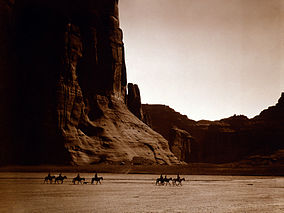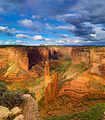- Canyon de Chelly National Monument
-
Canyon de Chelly National Monument 
Canyon de Chelly, 1904, by Edward S. CurtisLocation Apache County, Arizona, USA Nearest city Chinle Coordinates 36°09′19″N 109°30′32″W / 36.1552818°N 109.5089952°WCoordinates: 36°09′19″N 109°30′32″W / 36.1552818°N 109.5089952°W[1] Area 83,840 acres (33,929 ha)[2] Created April 1, 1931 Visitors 827,247 (in 2010)[3] Governing body Bureau of Indian Affairs NRHP Reference#: 70000066 Added to NRHP: August 25, 1970[4] Canyon de Chelly National Monument (
 /dəˈʃeɪ/ də·shā′) was established on April 1, 1931 as a unit of the National Park Service. It is located in northeastern Arizona within the boundaries of the Navajo Nation. Reflecting one of the longest continuously inhabited landscapes of North America, it preserves ruins of the early indigenous tribes that lived in the area, including the Ancient Pueblo Peoples (also called Anasazi) and Navajo. The monument covers 83,840 acres (131.0 sq mi; 339.3 km2) and encompasses the floors and rims of the three major canyons: de Chelly, del Muerto, and Monument. These canyons were cut by streams with headwaters in the Chuska mountains just to the east of the monument. None of the land is federally owned.[5]
/dəˈʃeɪ/ də·shā′) was established on April 1, 1931 as a unit of the National Park Service. It is located in northeastern Arizona within the boundaries of the Navajo Nation. Reflecting one of the longest continuously inhabited landscapes of North America, it preserves ruins of the early indigenous tribes that lived in the area, including the Ancient Pueblo Peoples (also called Anasazi) and Navajo. The monument covers 83,840 acres (131.0 sq mi; 339.3 km2) and encompasses the floors and rims of the three major canyons: de Chelly, del Muerto, and Monument. These canyons were cut by streams with headwaters in the Chuska mountains just to the east of the monument. None of the land is federally owned.[5]Contents
Name
The name chelly (or Chelley) is a Spanish borrowing of the Navajo word Tséyiʼ, which means "canyon" (literally "inside the rock" < tsé "rock" + -yiʼ "inside of, within"). The Navajo pronunciation is [tséɣiʔ]. The Spanish pronunciation of de Chelly [deˈtʃeʎi] was adapted into English, apparently through modelling after a French-like spelling pronunciation, and now English pronunciation: /dəˈʃeɪ/ də·shā′.
Description
Canyon de Chelly is unique among National Park service units, as it consists entirely of Navajo Tribal Trust Land which remains in the ownership of the Navajo Nation and is home to the canyon community, while park matters are administered by the National Park Service.[6] Access to the canyon floor is restricted, and visitors are allowed to travel in the canyons only when accompanied by a park ranger or an authorized Navajo guide.[7] The only exception to this rule is the White House Ruin Trail.
Most park visitors arrive by automobile and view Canyon de Chelly from the rim, following both North Rim Drive and South Rim Drive. Ancient ruins and geologic structures are visible, but in the distance, from turnoffs on each of these routes. Deep within the park is Mummy Cave. It features structures that have been built at various times in history. Tours of the canyon floor can be booked at the visitor center and at lodgings in the vicinity of the canyon. There is no fee to enter the canyon, apart from any charges imposed by tour guides.
Accommodations for visitors are located in the vicinity of the canyon, on the road leading to Chinle, which is the nearest town.
The National Monument was listed on the National Register of Historic Places on August 25, 1970.[4]
The park's distinctive geologic feature, Spider Rock, is a sandstone spire that rises 800 feet (240 m) from the canyon floor at the junction of Canyon de Chelly and Monument Canyon. Spider Rock can be seen from South Rim Drive. It has served as the scene of a number of television commercials. According to traditional Navajo beliefs the taller of the two spires is the home of Spider Grandmother.[8]
Gallery
-
White House Ruins, 1942, Ansel Adams photograph
-
Canyon de Chelly, 1941, Ansel Adams photograph
See also
- Ancient Pueblo Peoples
- Mesa Verde National Park
- Battle of Canyon de Chelly
References
- ^ "Canyon de Chelly National Monument". Geographic Names Information System, U.S. Geological Survey. http://geonames.usgs.gov/pls/gnispublic/f?p=gnispq:3:::NO::P3_FID:44981. Retrieved 2011-06-29.
- ^ "Listing of acreage as of 12/31/2010". Public Use Statistic Office, National Park Service. http://www.nature.nps.gov/stats/Acreage/acrebypark10cy.pdf. Retrieved 2011-06-29.
- ^ "Five Year Annual Recreation Visits Report". Public Use Statistic Office, National Park Service. http://www.nature.nps.gov/stats/viewReport.cfm?selectedReport=SystemComparisonReport.cfm. Retrieved 2011-06-29.
- ^ a b "National Register Information System". National Register of Historic Places. National Park Service. 2009-03-13. http://nrhp.focus.nps.gov/natreg/docs/All_Data.html.
- ^ "The National Parks: Index 2009–2011". National Park Service. http://www.nps.gov/history/history/online_books/nps/nps/part2.htm#cach. Retrieved 2011-06-29.
- ^ Brugge, David M.; Wilson, Raymond (1976). Administrative History: Canyon de Chelly National Monument, Arizona. National Park Service.
- ^ Egan, Timothy (June 16, 2011). "The Best Unknown Park in America". New York Times. http://opinionator.blogs.nytimes.com/2011/06/16/the-best-unknown-park-in-america/.
- ^ Tobert, Natalie; Pitt, Fiona (1994). Taylor, Colin F.. ed. Native American Myths and Legends. Salamander books ltd. p. 35. ISBN 0861017536.
- Grant, Campbell (1983). Canyon de Chelly: Its People and Rock Art. University of Arizona Press. ISBN 0-8165-0523-3.
External links
- "Canyon de Chelly National Monument". National Park Service. http://www.nps.gov/cach/index.htm. Retrieved 2011-06-29.
- "Canyon de Chelly National Monument". Geology Fieldnotes. National Park Service. http://www2.nature.nps.gov/geology/parks/cach/index.cfm. Retrieved 2011-06-29.
U.S. National Register of Historic Places Topics Lists by states Alabama • Alaska • Arizona • Arkansas • California • Colorado • Connecticut • Delaware • Florida • Georgia • Hawaii • Idaho • Illinois • Indiana • Iowa • Kansas • Kentucky • Louisiana • Maine • Maryland • Massachusetts • Michigan • Minnesota • Mississippi • Missouri • Montana • Nebraska • Nevada • New Hampshire • New Jersey • New Mexico • New York • North Carolina • North Dakota • Ohio • Oklahoma • Oregon • Pennsylvania • Rhode Island • South Carolina • South Dakota • Tennessee • Texas • Utah • Vermont • Virginia • Washington • West Virginia • Wisconsin • WyomingLists by territories Lists by associated states Other  Category:National Register of Historic Places •
Category:National Register of Historic Places •  Portal:National Register of Historic Places
Portal:National Register of Historic PlacesUnited States Ancient Pueblo dwellings in Arizona - Ancient Pueblo dwellings in Colorado - Ancient Pueblo dwellings in New Mexico - Ancient Pueblo dwellings in Utah - Ancient Pueblo dwellings in Texas - Ancient Pueblo dwellings in NevadaMexico Ancient Pueblo dwellings in Chihuahua - Ancient Pueblo dwellings in Sonora - Huápoca - Cuarenta CasasAfrica Asia Categories:- IUCN Category III
- Native American archeology
- Native American history of Arizona
- Native American museums in Arizona
- Pre-historic towns in the United States
- Protected areas of Apache County, Arizona
- Archaeological sites in Arizona
- National Park Service National Monuments in Arizona
- Protected areas established in 1931
- Former populated places in Arizona
- Cliff dwellings
- Museums in Apache County, Arizona
- Archaeology museums in Arizona
- Geography of the Navajo Nation
-
Wikimedia Foundation. 2010.







